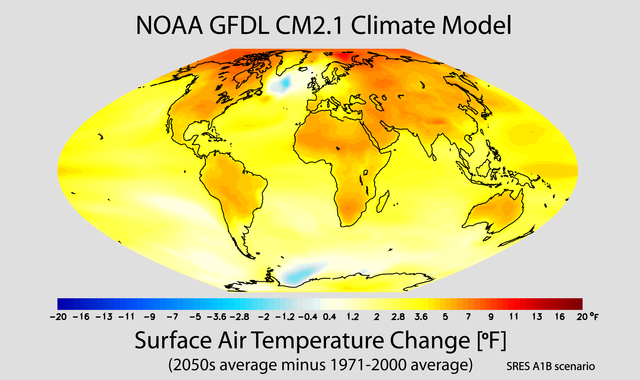 |
This is a file from the Wikimedia Commons. Information from its description page there is shown below.
Commons is a freely licensed media file repository. You can help.
|
Summary
| Description |
English: Description is based on the NOAA (2007a) public-domain source: This world map shows the projected change in annual mean surface air temperature from the late 20th century (1971-2000 average) to the middle 21st century (2051-2060 average). The change is in response to increasing atmospheric concentrations of greenhouse gases and aerosols based on a "middle of the road" estimate of future emissions. Future emissions are based on the "A1B" emissions scenario, taken from the Special Report on Emissions Scenarios. Warming is larger over continents than oceans, and is largest at high latitudes of the Northern Hemisphere. These results are from the GFDL CM2.1 model, but are consistent with a broad consensus of modeling results.
From the NOAA (2007b) public-domain source: The term “ global warming” is commonly used to refer to surface air temperature changes that are a response to increasing atmospheric greenhouse gas (GHG) concentrations. However, the warming is not expected to be uniform over the globe, nor is it expected to be the same during all seasons of the year. Computer model simulations conducted at NOAA’s Geophysical Fluid Dynamics Laboratory (GFDL) and elsewhere project that GHG induced warming will be more rapid over land masses than over oceans. In the image, red colors indicate greater warming over the continents. White and blue-green colors mark areas with the least warming or slight cooling, found mostly over oceans. Additionally, the greatest warming is expected during the winter over northern North America and north-central Asia.
References:
- NOAA, January 2007b: GFDL Climate Modeling Research Highlights: Patterns of greenhouse warming (PDF), vol. 1, no. 6, revision 2/2/2007, 8:50.08 AM. The National Oceanic and Atmospheric Administration (NOAA) Geophysical Fluid Dynamics Laboratory (GFDL) - Princeton, NJ
- NOAA, 2007a: see citation for the image.
|
| Date |
2 February 2007 |
| Source |
Very High Resolution Version 3200 x 1901 png (693KB), in: NOAA GFDL Climate Research Highlights Image Gallery: Patterns of Greenhouse Warming, publisher: NOAA GFDL. Retrieved 2012-10-13. |
| Author |
NOAA Geophysical Fluid Dynamics Laboratory (GFDL) |
Permission
( Reusing this file) |
From cited the cited source: "The materials presented here help illustrate some of the key research results that GFDL scientists have reported on recently. These graphics are considered to be in the public domain, and thus can be downloaded freely. We do request that if these images are used in publications or media broadcasts credit be given to "NOAA Geophysical Fluid Dynamics Laboratory" or at least "NOAA GFDL"."
|
Licensing
| Public domainPublic domainfalsefalse |
 |
This image is in the public domain because it contains materials that originally came from the U.S. National Oceanic and Atmospheric Administration, taken or made as part of an employee's official duties.
|
|
File usage
The following pages on Schools Wikipedia link to this image (list may be incomplete):
This file contains additional information, probably added from the digital camera or scanner used to create or digitize it. If the file has been modified from its original state, some details may not fully reflect the modified file.
Through Schools Wikipedia, SOS Childrens Villages has brought learning to children around the world. The world's largest orphan charity, SOS Children's Villages brings a better life to more than 2 million people in 133 countries around the globe. Have you thought about sponsoring a child?




